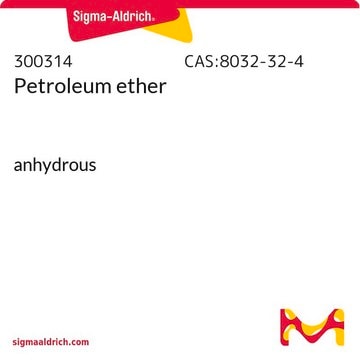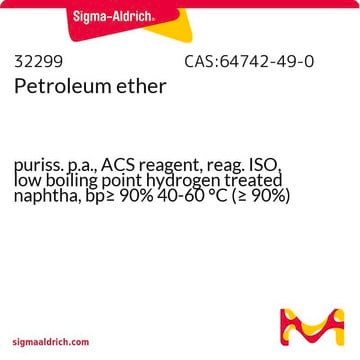1.00915
Éter de petróleo (bencina)
boiling range to about 40°C EMPLURA®
Sinónimos:
Petroleum ether, Petroleum spirit, Petroleum ether
About This Item
Productos recomendados
Quality Level
product line
EMPLURA®
form
liquid
autoignition temp.
245 °C
expl. lim.
1.3-7.8 % (v/v)
impurities
≤0.00002% Al (Aluminium)
≤0.0005% Free acid (as CH3COOH)
≤0.01% Aromatics (as benzene)
≤0.01% Sulfur compounds (as S)
≤0.01% Water
evapn. residue
≤0.0020%
bp
<40 °C/1013 hPa
bromine number
≤3
transition temp
flash point -56 °C
density
0.63 g/cm3 at 20 °C
cation traces
Al: ≤0.00002%
Ba: ≤0.00001%
Ca: ≤0.0001%
Cd: ≤0.00001%
Co: ≤0.00001%
Cr: ≤0.000003%
Cu: ≤0.000003%
Fe: ≤0.000003%
K: ≤0.00003%
Mg: ≤0.00001%
Mn: ≤0.000003%
Na: ≤0.0001%
Ni: ≤0.000003%
Pb: ≤0.00001%
Sr: ≤0.000003%
Zn: ≤0.00003%
storage temp.
2-30°C
¿Está buscando productos similares? Visita Guía de comparación de productos
General description
Application
- Ginkgo Biloba L. Exocarp Extracts: Utilizing petroleum benzine for solvent extraction, this research explores the anti-microbial potential of Ginkgo biloba L. exocarp extracts against methicillin-resistant Staphylococcus aureus, indicating its significant role in pharmaceutical applications (Wei et al., 2024).
- Creating Mesopores in ZSM-5 Catalyst for Aromatics Production: This application of petroleum benzine in the synthesis of biodiesel-derived waste glycerol showcases innovative use in catalytic processes to enhance aromatic production, beneficial for both environmental and industrial chemistry (Kumar et al., 2024).
- High-Speed Countercurrent Chromatography for Bioactive Neolignan Isomers: Demonstrating the use of petroleum benzine in chromatographic techniques, this method significantly aids in the isolation of complex organic compounds, crucial for advanced research in natural product chemistry (Xiao et al., 2024).
- Hydrocarbon Ingestions and Poison Control: While indirectly related, the study uses data on hydrocarbon ingestions to emphasize the importance of safety and environmental impact assessments in the use of petroleum products, including benzine, within public health contexts (Palmer et al., 2023).
Analysis Note
Free acid (as CH₃COOH): ≤ 0.0005 %
Density (d 20 °C/ 4 °C): 0.623 - 0.627
Readily carbonizable substances: conforms
Evaporation residue: ≤ 0.0020 %
Water: ≤ 0.010 %
Aromatics (as benzene): ≤ 0.01 %
Sulfur compounds (as S): ≤ 0.01 %
Bromine number: ≤ 3
Al (Aluminium): ≤ 0.00002 %
Ba (Barium): ≤ 0.00001 %
Ca (Calcium): ≤ 0.0001 %
Cd (Cadmium): ≤ 0.00001 %
Co (Cobalt): ≤ 0.00001 %
Cr (Chromium): ≤ 0.000003 %
Cu (Copper): ≤ 0.000003 %
Fe (Iron): ≤ 0.000003 %
K (Potassium): ≤ 0.00003 %
Mg (Magnesium): ≤ 0.00001 %
Mn (Manganese): ≤ 0.000003 %
Na (Sodium): ≤ 0.0001 %
Ni (Nickel): ≤ 0.000003 %
Pb (Lead): ≤ 0.00001 %
Sr (Strontium): ≤ 0.000003 %
Zn (Zinc): ≤ 0.00003 %
Legal Information
signalword
Danger
Hazard Classifications
Aquatic Chronic 2 - Asp. Tox. 1 - Flam. Liq. 1 - Skin Irrit. 2 - STOT SE 3
target_organs
Respiratory system
Storage Class
3 - Flammable liquids
wgk_germany
WGK 3
flash_point_f
-68.8 °F
flash_point_c
-56 °C
Certificados de análisis (COA)
Busque Certificados de análisis (COA) introduciendo el número de lote del producto. Los números de lote se encuentran en la etiqueta del producto después de las palabras «Lot» o «Batch»
¿Ya tiene este producto?
Encuentre la documentación para los productos que ha comprado recientemente en la Biblioteca de documentos.
Los clientes también vieron
Nuestro equipo de científicos tiene experiencia en todas las áreas de investigación: Ciencias de la vida, Ciencia de los materiales, Síntesis química, Cromatografía, Analítica y muchas otras.
Póngase en contacto con el Servicio técnico










